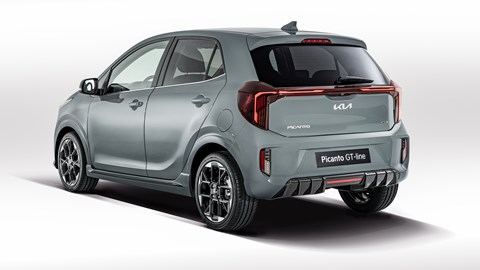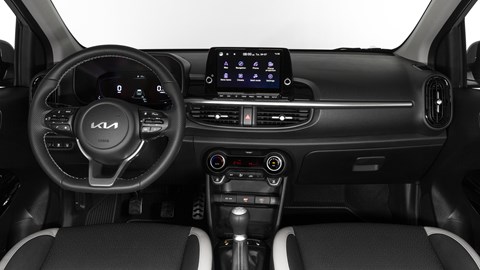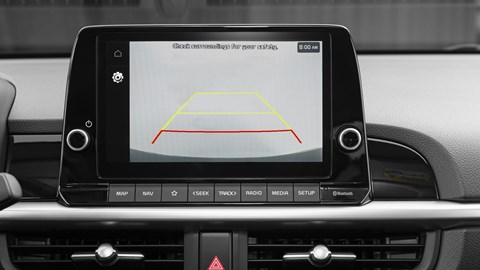► Major facelift for Kia’s city car
► EV9-inspired looks and updated interior
► Two engine options, reduced trim range
This aggressive-looking little number is the heavily updated Kia Picanto. Yes, while most manufacturers are departing the A-segment as quickly as their little legs will let them, Kia remains a staunch advocate that the pointy end of the market is still a worthwhile place to operate. That it’s competing for the same buyers with about half as many rival small cars as it did a decade ago doesn’t hurt sales, either.
Though it’s mostly a visual refresh the changes to the Picanto should keep it fighting fit until the end of its days, when it’ll inevitably be replaced with an EV of sorts.
Quite the visual upgrade
For 2024 Kia’s pushed the boat out and renosed the Picanto to give it greater synergy with other models in the range, particularly the latest Niro and the EV9. To that end there are angular LED daytime running lights stretching the full width of the front – GT-Line cars get an LED light bar connecting the two light clusters, though for lower-spec models this’ll be just a chrome strip.

The headlights themselves are vertically stacked while the pinstriped indicators are inboard. The ‘Tiger Nose’ grille’s been reduced to a bare slit, and there’s plenty of aggression round the air intakes and lower grille.
The side sees some new gloss black trim at the bottom of the doors while the rear has new taillights described as ‘almost’ full-width. The badges have shifted to the lower portion of the tailgate.
All these changes are aimed at giving the Picanto more visual width, and unusually Kia’s resisted the urge to give in and load it up with SUV styling cues. “Not like the Toyota Aygo X,” a Kia rep confided in us, a little disparagingly. As a result the previously available X-Line trim, with raised ride height and wheelarch extensions, won’t make a comeback.
There are also four new paint colours including ‘Sporty Blue’ and ‘Adventurous Green’, pictured. The range also contains ‘Milky Beige’, for the less aggressive.
What’s new under the bonnet?
Significantly less than on the outside. The Picanto retains the 1.0-litre three-cylinder and 1.2-litre four-cylinder engines available before, though they’ll be slightly retuned so final power outputs are yet to be revealed. Don’t expect too much different from the 66bhp and 83bhp previously available, though – if anything, they may be mildly detuned to improve CO2 emissions.
Sad news is the demise of the 1.0-litre turbocharged model, which proved itself an absolute hoot to drive. Its higher emissions and fuel consumption were always somewhat of a sore thumb in the range, and it only ever accounted for about five per cent of UK sales – and even fewer in the rest of Europe.
And inside?
Sod tout, frankly. There’s a new ‘fully digital’ instrument cluster – but this is a slightly mealy way of saying that instead of needles you get LCD lights filling up a bar, rather than a full-width display.

All models including the base-spec now get the touchscreen infotainment system as well as sat-nav. Apple CarPlay and Android Auto will be offered – specifically wired, even with models that have a wireless charging pad fitted. Kia does this to try and encourage drivers to use its own connected systems.
Some models will get faux leather trim, and there are two interior colour packs in Adventurous Green and Rich Brown. Kia’s not too sure if these will make it to the UK.
What models and trims will be available?
Specs for the UK are yet to be finalised but it’s looking likely that the range will run with 2, 3, GT-Line and GT-Line S trim levels. The latter two receive visual upgrades, including the aforementioned LED light bar. As before, top trims will get a surprising amount of kit for a city car, including heated seats, climate control, LED lights and even a sunroof.
Funky alloy wheels are specific to each trim, up to 16-inches on the GT-Line S, and even base models with steelies have surprisingly convincing-looking wheel covers.

The 1.0-litre and 1.2-litre engines will both come with a five-speed manual as standard, though a five-speed automated manual will remain available as an option. One best left alone.
Is there still a future for small Kias?
Kia reckons so. Product manager Andrea de Arcangelis promised that the Picanto was here to stay. Being sold in every market Kia is in, bar North America, allows massive economies of scale to contribute to the car’s success, and while other manufacturers are finding it difficult to compete he admitted ‘The A-Segment is still profitable for Kia’.
In fact, it’s hoped that top-spec variants of the Picanto will mop up the customers who would have purchased the now-discontinued Rio.
An electric Picanto is possible – Kia’s previously said it would offer an EV in every market segment it’s currently occupying – but it’s highly unlikely it would be on this platform and we’d have to wait for a totally new model.